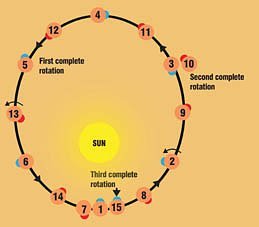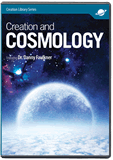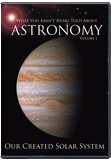
Mercury—The Tiny Planet that Causes Big Problems for Evolution
Our Solar System’s Second-Smallest—and Speediest—Planet Is Still Causing Surprises
Originally published in Creation 26, no 4 (September 2004): 36-39.
Tiny Mercury has much to say about the origins of our solar system.
Mercury—of the nine known planets of our solar system, it is the closest to the sun. It is also one of the smallest, only Pluto (the furthermost) being smaller. Even Ganymede (a moon of Jupiter) and Titan (a moon of Saturn) are bigger. Yet, tiny Mercury has much to say about the origins of our solar system.
Mercury is a planet of extremes. The side of the planet that faces the sun reaches a temperature of about 430°C (more than enough to melt lead), while the dark side is a frigid –170°. Mercury revolves around the sun every 88 days, and has the unusual characteristic of rotating on its axis exactly three times for every two complete orbits.
Much of our information about Mercury comes from the Mariner 10 fly-by of 1974–75. Lacking the variety and colour of some other planets, Mercury’s rocky, cratered surface resembles the moon’s [see picture below]. But what is really interesting about Mercury are the things that can’t be seen.

Scientists have discovered that Mercury has the highest density of all the known planets (other than Earth). Mercury is so dense that it’s thought to have an iron core occupying some 75% of its diameter.1 This extraordinary density has generated much turmoil and confusion in evolutionary astronomy. Evolutionists mostly agree on models of planetary formation … but their models say Mercury can’t be anywhere near as dense as it actually is.
Colliding with evolution
After decades of struggle, most astrophysicists today have given up and admitted that Mercury’s high density cannot be accommodated within slow-and-gradual-development models.
Instead, the preferred explanation now is that billions of years ago, a large object crashed into Mercury, stripping away its lesser-density material, and leaving behind the high-density planet seen today.2
Mariner missions of the 1960s and 70s

Mariner 10 was the last of its series of spacecraft and the first mission to use the gravitational pull of one planet (Venus) to reach another (Mercury). The craft was launched in 1973 and reached Mercury on 29 March 1974. During the following year it returned 10,000 images of the planet and had mapped 57% of the surface when its power became exhausted. It is now in orbit around the sun.
Consider the implications of this. Evolutionists have admitted that the planet that we see today cannot be explained by gradual evolutionary processes! This is a stunning admission. Instead, they propose a long-ago catastrophic collision. What is the evidence for this collision? Only that Mercury would otherwise disprove evolution!
Over and over again in astronomy, cosmic collisions are invoked as a sort of magic wand to rescue evolutionary theories from the facts. The planet Uranus is tilted over, but evolution says it can’t be—therefore, long ago something hit it and knocked it over. Venus’s rotation contradicts evolutionary predictions—therefore, long ago something hit it and spun it round the opposite way.
Mars’ atmosphere is too thin for evolutionist tastes—therefore, it used to be thicker, but long ago something hit Mars and stripped most of it away. Mercury is too dense for evolution—therefore, long ago something hit it and conveniently removed the lighter parts. Evolutionists wave their collision-wand at will, and yet mock as “unscientific” the Christian belief in a one-off catastrophic global Flood, despite the abundant physical and historical evidence for it.
Magnetic Mercury
Mercury’s challenges to naturalism are not limited to its density. Evolutionists received another rude jolt when Mercury’s magnetic field was discovered. To understand why this poses a problem, we must discuss evolutionary ideas of planetary magnetism.
Most solar system planets have significant magnetic fields. Where do these fields come from? Evolutionists (and long-age creationists) hold to a “dynamo” theory, which requires those planets with magnetic fields to also have molten metal cores.
Through a complicated series of events, fluid motions inside the core can supposedly generate a magnetic field. Evolutionists believe this idea because it is the only mechanism they have been able to propose by which planets supposedly billions of years old could still have magnetic fields—all of the other mechanisms would require that the planets be very young.
Mercury Morsels
- Unlike most other planets, Mercury has no moons
- Its thin atmosphere is made of helium and sodium
- A year on Mercury is only ≈ 88 Earth-days but one of its days ≈ 59 Earth-days long!
- On Mercury, you could jump 2½ times as high as on Earth
Unfortunately for the long-agers, the more we discover about other planets, the more we find that the dynamo model cannot be true for them.3 This shouldn’t really surprise us, however, since many long-agers admit that even the earth itself poses huge problems for the dynamo model, and the earth is the planet that the model was first invented to explain!4
Back to Mercury. To be billions of years old and still have a magnetic field, there must be fluid motions within a planet’s core. Therefore, the core itself must be molten. But as one evolutionist says, “Mercury is so small that the general opinion is that the planet [i.e. its core] should have frozen solid aeons ago”.5 Therefore, the core cannot be molten, and so evolutionary theories would have to conclude that Mercury cannot have a magnetic field. But it does!
Some evolutionists speculate that perhaps Mercury’s core isn’t iron (which would have “frozen solid eons ago”), but iron sulfide instead (which wouldn’t necessarily have solidified over these supposed eons). But in solving the problem for Mercury, a much bigger problem is created.
More on Mercury
Mean distance from sun: 57,910,000 km
Equatorial radius: 2439.7 km
Equatorial escape velocity: 4.25 km/sec
Rotational period: 58.6462 days
 Orbital period: 87.969 days
Orbital period: 87.969 days
Temperatures:
Mean surface 179°C
Maximum surface 427°C
Minimum surface –173°C
A fundamental principle of the solar nebula theory (used to explain how our solar system formed) is that there cannot be any volatile elements such as sulfur this close to the sun, and so there shouldn’t be any iron sulfide in Mercury. Thus, in trying to rescue a billions-of-years age for Mercury, evolutionists are undermining the very foundations of their ideas about the formation of the entire solar system.6
Creationists have no problem explaining the magnetic field of Mercury, nor that of any other planet. There are several ways in which a young (6,000-year-old) planet could still have a magnetic field.7 But since evolutionists reject a young creation, they cannot explain planetary magnetism. As one evolutionist says, “Magnetism is almost as much of a puzzle now as it was when William Gilbert (1544–1603) wrote his classic text Concerning Magnetism, Magnetic Bodies, and the Great Magnet, Earth in 1600”!8
When a Christian examines the solar system, it is easy to wonder if the Creator designed the planets specifically to confound non-creationary explanations of them. Repeatedly, new discoveries contradict naturalistic ideas. Ironically enough, in the case of Mercury, even evolutionists admit to this, after a fashion. They admit that any attempt to include Mercury in their evolutionary models will doom the models to failure—they say that Mercury is a “trap”9 that has “seduced”10 evolutionists, and has had a “fatal attraction for solar system modellers.”11
So we see that this tiny, seemingly insignificant planet creates enormous stumbling blocks for those who wish to deny the Creator. Truly, “God has chosen the foolish things of the world to confound the wise; and God has chosen the weak things of the world to confound the things which are mighty” (1 Corinthians 1:27).

Planet puzzle
If you were standing on Mercury, you would see the sun rise, then immediately set again before rising again and travelling westwards. Similarly, at sunset, it rises again briefly, before setting once more. This is due to the way Mercury’s rotation combines with its very elliptical (egg-shaped) orbit.
Footnotes
- Whether or not the details of this model are correct, the very high density of Mercury is a fact, as it is based on measurements and observations. For example, we observed the planet’s gravitational pull on Mariner 10. See all footnotes
- “The driving force behind previous attempts to account for Mercury has been to fit the high density of the planet into some preferred overall solar system scheme … . It has become clear that none of these proposed models work, and the high density is conveniently accommodated by the large-impact hypothesis, which makes Mercury unique.” Taylor, S.R., Solar System Evolution: A New Perspective, Cambridge University Press, New York, p. 194, 1992. See all footnotes
- See, for example, Creation 24(3):38–40, 2002 for a discussion of Uranus, and Creation 25(1):22–24, 2002 for a discussion of Neptune. See all footnotes
- For more documentation, see Sarfati, J., The earth’s magnetic field, Creation 20(2):15–17, 1998. For a more in-depth explanation, including documentation from a variety of secular journals, see Humphreys, R., The Earth’s magnetic field is still losing energy, <www.creationresearch.org/crsq/articles/39/39_1/GeoMag.htm>, 30 July 2002. See all footnotes
- Taylor, S.R., Destiny or Chance: our solar system and its place in the cosmos, Cambridge University Press, Cambridge, p. 163, 1998. See all footnotes
- Some evolutionists recognize this. “A pure iron core would have frozen long ago, so the most likely candidate is an FeS core … . The presence of the volatile element sulfur as a constituent of the planet closest to the sun has important implications for models of planetary accretion. If Mercury contains a substantial (2–3%) sulfur content, then this removes much of the rationale for a heliocentric zoning of nebular composition. Models in which Mercury accretes from high-temperature components only are no longer viable. If the innermost planet has a substantial volatile component (although FeS is the probable source of the sulfur), there is little basis for condensation models of planetary accumulation based on heliocentric distance.” Taylor, S.R., Solar System Evolution, p. 191, emphasis added. See all footnotes
- See Humphreys, R., The creation of planetary magnetic fields, <www.creationresearch.org/crsq/articles/21/21_3/21_3.html>, for one possibility. See all footnotes
- Taylor, S.R., Destiny or Chance, pp. 163–164. See all footnotes
- Taylor, S.R., Destiny or Chance, p. 166. See all footnotes
- Taylor, S.R., Destiny or Chance, p. 166. See all footnotes
- Taylor, S.R., Destiny or Chance, p. 166. See all footnotes
Recommended Resources

Answers in Genesis is an apologetics ministry, dedicated to helping Christians defend their faith and proclaim the good news of Jesus Christ.
- Customer Service 800.778.3390
- © 2025 Answers in Genesis





